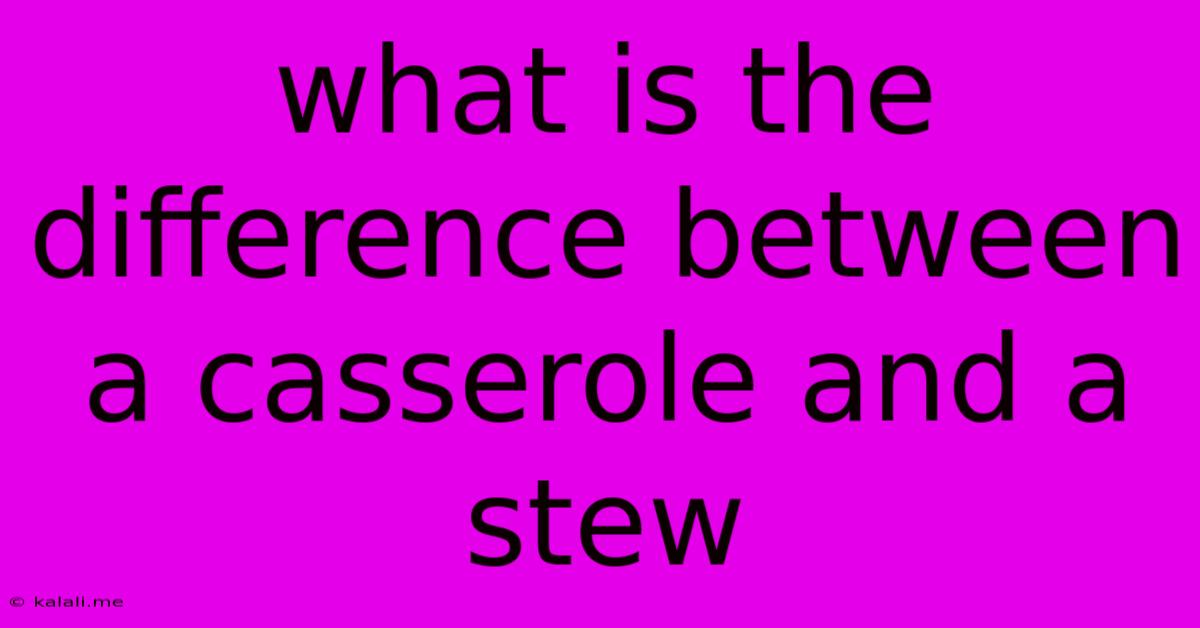What Is The Difference Between A Casserole And A Stew
Kalali
May 19, 2025 · 3 min read

Table of Contents
Casserole vs. Stew: Unraveling the Culinary Conundrum
So, you're standing in the grocery store, recipe book in hand, and you're faced with a dilemma: is this dish a casserole or a stew? While both are hearty, comforting meals perfect for chilly evenings, there are key differences that set them apart. This article will delve into the nuances of casseroles and stews, helping you understand their unique characteristics and confidently navigate the culinary landscape. Learn the defining features of each dish, discover the best ingredients for each, and understand how to prepare them for optimal results.
What is a Casserole?
A casserole is essentially a baked dish, typically featuring a combination of meat, vegetables, and a creamy or cheesy sauce, all baked together in a single dish, usually a shallow oven-safe dish. The baking process is crucial; it's what creates the bubbly, browned top and the overall texture of the casserole. Think of classics like tuna noodle casserole, chicken pot pie (though some might debate this one!), or shepherd's pie.
Key Characteristics of a Casserole:
- Baked: This is the defining characteristic. The dish is always baked in an oven.
- Layered or Combined: Ingredients are often layered or thoroughly combined before baking.
- Often Creamy or Cheesy: Many casseroles incorporate a creamy sauce, cheese, or both, contributing to their rich and comforting nature.
- Top-Browned: The top of a properly baked casserole will have a golden-brown crust.
- Served Hot: Casseroles are almost always served hot, straight from the oven.
What is a Stew?
A stew, on the other hand, is a one-pot dish simmered on the stovetop or in a slow cooker. It typically features chunks of meat and vegetables in a flavorful broth or sauce, allowing the flavors to meld and deepen over time. Think beef stew, chicken stew, or vegetable stew.
Key Characteristics of a Stew:
- Simmered: This is the core method of preparation; slow simmering is key to developing flavor.
- One-Pot Dish: Typically prepared in a single pot, minimizing cleanup.
- Brothy or Saucy: Stews are characterized by a significant amount of liquid, creating a flavorful broth or sauce.
- Tender Meat and Vegetables: Long simmering times result in tender, easily broken-down meat and vegetables.
- Served Hot or Cold (Sometimes): While often served hot, some stews can be enjoyed cold or at room temperature.
Key Differences Summarized:
| Feature | Casserole | Stew |
|---|---|---|
| Cooking Method | Baked in the oven | Simmered on the stovetop or slow cooker |
| Consistency | Thick, often creamy or cheesy | Brothy or saucy, less dense |
| Texture | More varied textures, potentially crusty top | Generally uniform, tender meat and veg |
| Ingredients | Often layered, includes binding agent | Simmered together in a liquid base |
Beyond the Basics: Exploring Variations
While these are the general guidelines, there are always exceptions. Some dishes blur the lines, incorporating elements of both casseroles and stews. For example, a chicken and vegetable bake might be considered a casserole if baked with a creamy sauce, but a similar dish simmered in broth would be classified as a stew. The key is to focus on the primary cooking method and the overall consistency of the dish.
Understanding these key distinctions will help you better appreciate the unique qualities of each dish and confidently identify them in recipes and on menus. So, next time you're deciding between a casserole and a stew, remember this guide and choose the perfect comforting meal for your next gathering!
Latest Posts
Latest Posts
-
How Long Will Homemade Cheesecake Last
May 19, 2025
-
True Or False Weight Is A Force
May 19, 2025
-
Twixt The Cup And The Lip
May 19, 2025
-
Throughout Heaven And Earth I Alone Am The Honored One
May 19, 2025
-
New Brakes Squeak When Stopping Slow
May 19, 2025
Related Post
Thank you for visiting our website which covers about What Is The Difference Between A Casserole And A Stew . We hope the information provided has been useful to you. Feel free to contact us if you have any questions or need further assistance. See you next time and don't miss to bookmark.